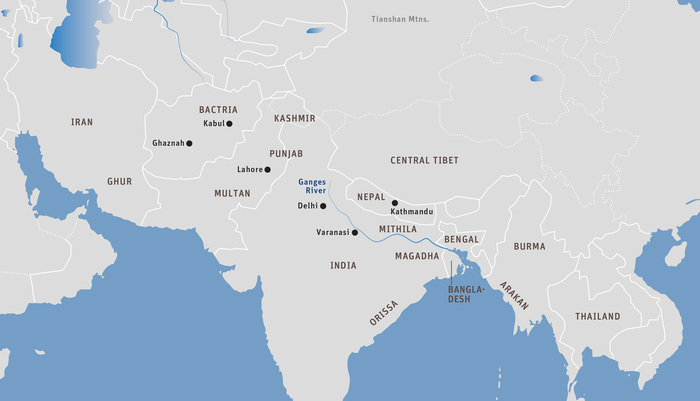Although Hinduism and Jainism were able to survive the Ghurid invasion of northern India, Buddhism never fully recovered. It gradually began to disappear. Granted that this loss was a complex phenomenon, let us examine a few of the factors that might explain it.
The Hindus and Jains had no universities or large monasteries. Their monks lived alone or in small groups in remote regions, studying and meditating privately, with no community rituals or ceremonies. Since they posed no threat, it was not worth the invaders’ time or efforts to destroy them. They damaged only the Hindu and Jain temples found in the major cities for laypeople. The Buddhists, on the other hand, had large, imposing monastic universities, surrounded by high walls and fortified by the local kings. Their razing clearly had military significance.
The fact that only the Buddhist institutions suffered severe destruction, and mostly only those on the major paths of the troops’ advance, is further evidence that although the Ghurids called their campaign a holy war, its actual aim was not converting infidels to Islam. Had it been, they would have focused on the religious communities of the Hindus, Jains, and Buddhists alike, regardless of their size or location.
For laypeople in India, Buddhism was primarily a religion of devotion focused around the large monasteries. Although there was a forest tradition for intense meditation, those who wished to study deeply became celibate monks or nuns. Householders offered food and material support for the monastics. They came twice a month to the monasteries for a day of keeping vows of ethical discipline and listening to sermons based on the scriptures. They did not regard themselves, however, as a separate group from the Hindu majority. For ceremonies marking rites of passage in their lives, such as birth, marriage, and death, they relied on Hindu rituals.
When Hinduism identified Buddha as a manifestation of its supreme god Vishnu, the Buddhists did not object. In fact, throughout northern India, Kashmir, and Nepal, Buddhism was already mixed with many elements of devotional Hinduism. Therefore, when the major monasteries were destroyed, most Buddhists were easily absorbed into Hinduism. They could still focus their devotion on Buddha and be considered good Hindus. Hinduism and Jainism, on the other hand, were more oriented to laypeople’s practice in the home and did not require monastic institutions. When Hindu theologians identified Jina Rshabha, one of the major Jain figures, as an incarnation of Vishnu, the Jains protested.
Furthermore, Hindus and Jains were useful to the Muslim conquerors. The Hindus had a warrior caste that could be conscripted into service, while the Jains were the major local merchants and sources of tax. The Buddhists, on the other hand, did not have a distinguishing occupation or service as a people as a whole. They no longer played a role in interregional trade as they had centuries earlier when Buddhist monasteries dotted the Silk Route. Therefore, whatever efforts there were for conversion to Islam were directed primarily toward them.
Further, many Buddhists were considered to be of the lower castes in Indian society and had been receiving prejudiced treatment under Hindu rule. Many who accepted Islam were undoubtedly attracted by the promise of equality and brotherhood to all who accepted this faith. Hindu converts to Islam, on the other hand, were considered as outcastes by other Hindus, regardless of their castes of origin. Since Buddhists were already treated as outcastes, they did not suffer a change in social status within a predominantly Hindu community when they converted.
Thus, although most of northern India remained Hindu, with pockets of Jains, Punjab and East Bengal gradually had the most converts. The Buddhists in the former had the longest contact with Islam, particularly enhanced with the flood of Islamic masters from Iran and the Middle East that sought refuge there from the Mongol attacks that began in the early thirteenth century. East Bengal, on the other hand, has always been a land with many impoverished peasants who would be ripe for the appeal of equality with Islam.
